Studio Visit
In His Bronx Studio, Artist Timothy Hull Infuses the Ancient Greek World With a Modern Pop Ethos
The artist, who works between the city and upstate New York, mixes his passion for pre-Socratic culture with a Memphis design touch.
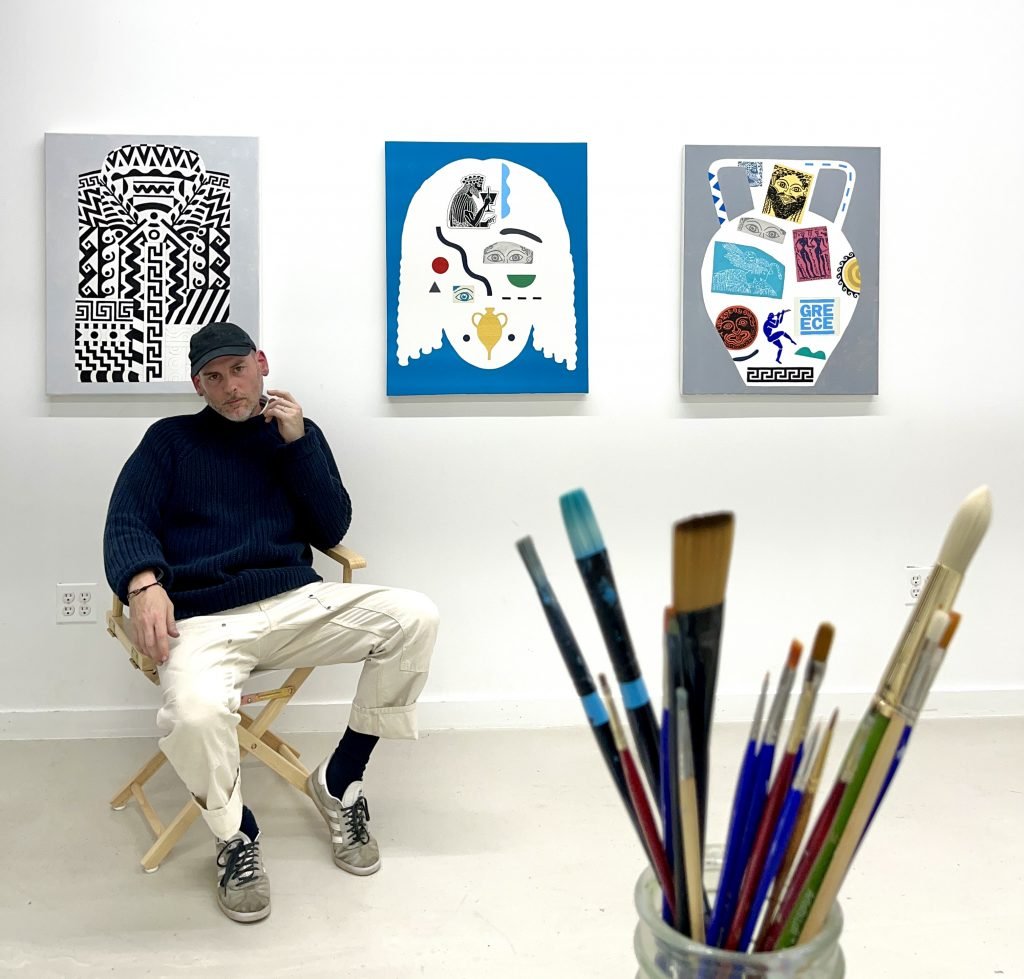
The artist, who works between the city and upstate New York, mixes his passion for pre-Socratic culture with a Memphis design touch.

Katie White

Timothy Hull is an artist alive with fascination. His passions range from the obscured histories of the pre-Socratic ancient world to the lives and works of artists and musicians from Oscar Wilde to Sinéad O’Connor. In person, Hull conveys these interests with a bright liveliness and a contagious enthusiasm which carries over into his crisp and playful paintings and drawings steeped in imagery culled from ancient Greek and Italian societies. In his studio, one’s eye is immediately struck by the vibrant Aegean blues and brilliant whites that dominate his paintings and ballpoint pen drawings—distinctly Mediterranean hues. Ancient kouros, amphora vases, and Greek letters dance across these compositions, but all here infused with a 1980s Pop sensibility distinctive to Hull and which ranges from Memphis patterns to Swatch watches.
Hull, who has exhibited with Ashes/Ashes and Klaus Von Nichtssagend Gallery in recent years, has long kept a studio in Warwick, New York— a light-filled converted barn on his home’s idyllic property. Having lived in New York City for many years, the artist recently decided to rent a second studio in the Mott Haven section of the Bronx, for studio visits and a sense of artist community (Hull has recently received visitors including musician Michael Stipe, and artists TM Davy and Paul Mpagi Sepuya).
Recently, we spoke with Hull about this studio practice, both upstate and in the city, growing up the son of an academic, and how Naples (and espresso) fuels his practice.
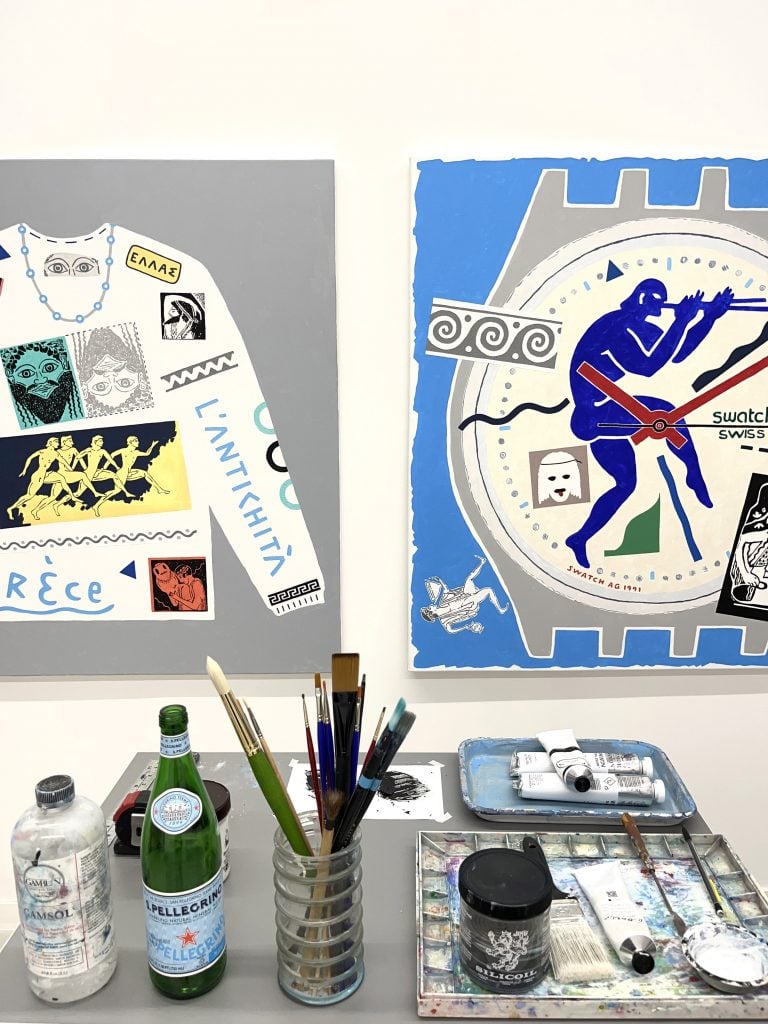
A snapshot inside Timothy Hull’s studio, 2024. Courtesy of the artist.
Tell me about your studio. I know you recently rented a studio space in the Bronx.
After primarily working in Warwick, New York, for six years, I recently moved my studio practice back to New York City, renting a space in the South Bronx, which has proved quite fun and fruitful so far. Here in Mott Haven, there is a sense of an older New York City, one that still has grit and verve. Also, being not too far of a commute from Warwick, where I still live, is a plus.
What does each of these two spaces—upstate and in the city—offer you as an artist?
Upstate, I work in an environment that is very charming, quiet, and remote. However, being a Gemini, I need the tension of opposites. Working in the city gives me that balance; wherein I can be very social and do studio visits in the Bronx and very quiet and isolated in the country.
What’s a typical day in the studio for you?
I am a very quotidian, focused worker. I love being in the studio eight hours a day, when and if possible. A long day in the studio, to me, is like a long day at the beach to someone else. I teach two days a week, so I can be in the studio more than I’m called to be anywhere else. Being a morning person, I like to get in there by 8 a.m. I usually accomplish any major creative work by noon. Afternoon work is usually more meditative, completing particular passages of paintings or sketching, reading.
What is the first thing you do when you walk into your studio (after turning on the lights)?
The minute I walk into the studio I greet the space with thanksgiving. I burn some incense, ring a series of bells. This ritual generates a fresh and open energy within the space. I want to signal to the universe that I do not take the struggles, sacrifices, and joys of being an artist for granted. Then, I can get down to work.
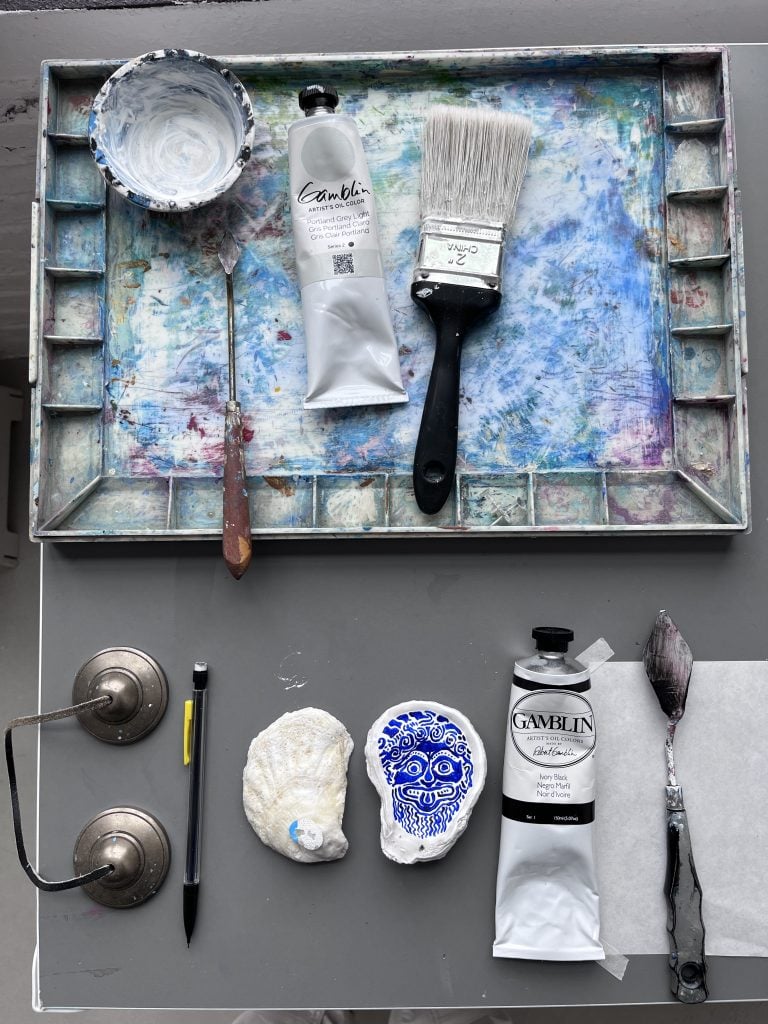
Hull’s painting table at his Bronx studio, with Gamblin paint and the oyster shells he often includes in his works. Courtesy of the artist.
How would you describe the atmosphere of your studio? Do you listen to music?
The conceptual atmosphere of my studio is like Indiana Jones’s office. I like to think that I’m tinkering around history and discovering or illuminating ancient ideas, piling stuff up, dusting it off, and arranging it anew. However, the atmosphere is also like a coffee bar in Rome. There’s always the aroma of espresso and Italian news and music drifting through the air. Recently, I have been primarily listening to Il Grande Fulmine, a new album by the Neopolitan group Thru Collected, or the entire catalogue of Bartolini, a Rome-based musician. The grand majority of the music I listen to comes out of Napoli, probably the most creatively vibrant city of this time.
Do you have any visual inspirations in the studio or the works of any other artists?
Since 2006, I have had this Artforum ad in my studio for Mat Cerletty’s show “Falling Water” at Rivington Arms. His exhibition blew my mind and set the standard for a bizarre, discursive yet super-tight exhibition. I also have images of popes, saints, mystics, a photo Paul Mpagi Sepuya took of me, and of course, Wayne and Garth because they are my absurdist spirit guides. They always remind me to have a spring in my step and not take things so seriously.
I know you’re fascinated by history. Can you tell me about how ancient cultures influence your work? What’s inspiring about it?
History is indeed fascinating. Those who fail to learn it are condemned to repeat it! I think of myself as an artist and historian because really my work is about how the ancient past informs contemporary ideas. My father is Professor Emeritus at N.Y.U., in African history, and growing up in that inquisitive and scholarly environment certainly had an influence. I recently received a travel research grant from the City University of New York to visit certain collections of antiquities in Rome and Napoli. The MANN museum in Napoli has one of the best collections of Magna Grecia, a form of diasporic vase painting that interests me greatly.
To be specific, I am particularly taken by pre-Socratic cult and homosexual imagery from Ancient Greece. It’s compelling to slam contemporary sensibilities of image-making up against such ancient forms. There is still so much to learn from the past, and in some respects, I think that I am navigating uncharted waters of queer and cult imagery from antiquity.
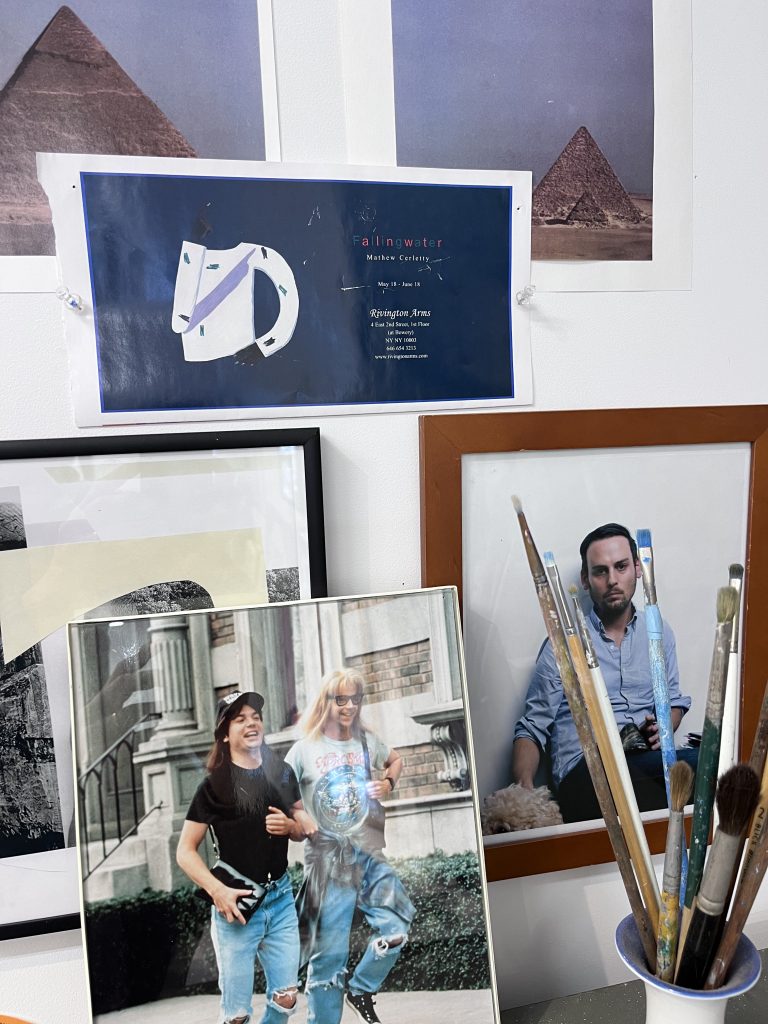
Hull’s studio wall of inspiration.
How do you end your studio days? Do you have a routine or ritual?
The last thing I usually do is talk to my paintings. I believe, like Carl Jung, that inanimate objects can have psychic lives; there is an energy to them. I speak blessings over them, argue about ideas with them, lament and praise them, ask them to give me a break. Painting is hard work! What’s the hardest thing about painting? The first 20 years!
What’s the last exhibition that made an impression on you and why?
The last museum exhibition I saw was the “Manet/Degas” show at the Metropolitan. I thought I knew a lot about these artists but I learned so much from spending time with their work. I also loved the re-hang of the European paintings. It’s like seeing old friends in new digs. The most recent gallery exhibition was TM Davy’s show “Fae” at Company. TM is my closest friend and confidant, and I went to his show a number of times during its run.
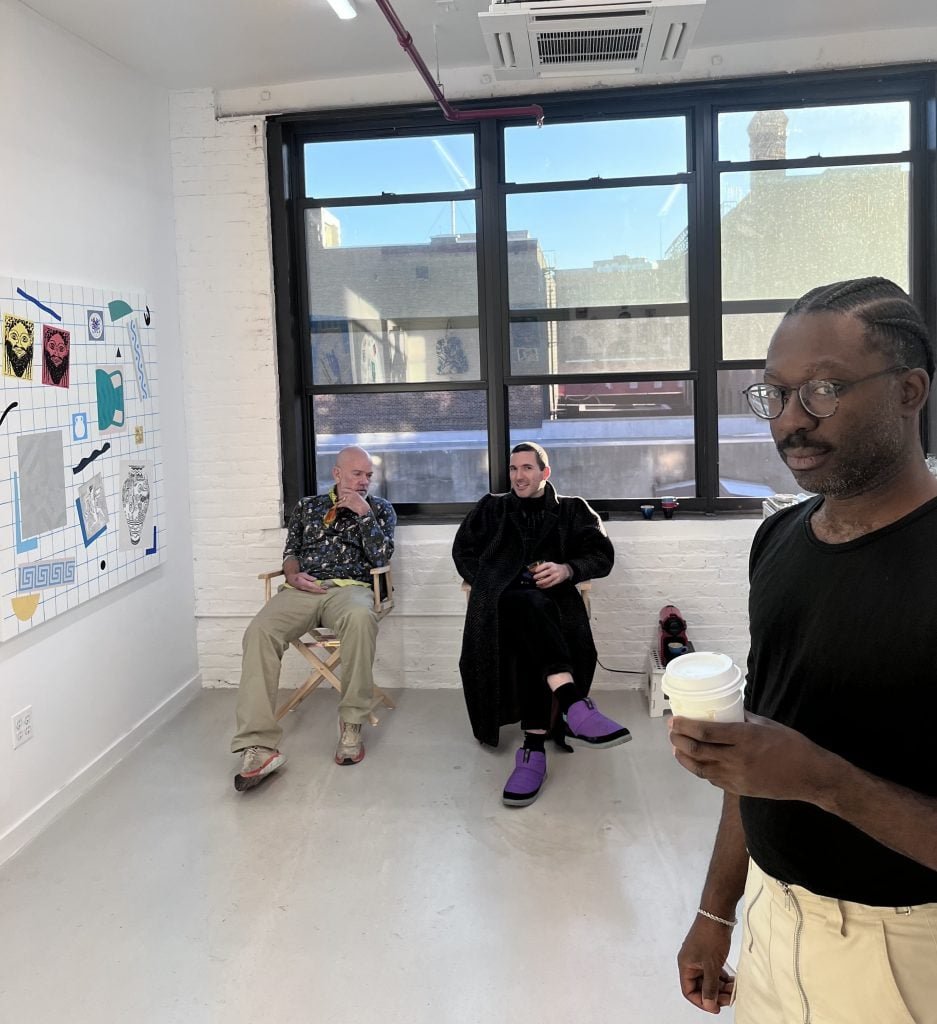
Michael Stipe, TM Davy, and Paul Mpagi Sepuya pay a visit to Hull’s studio, 2024.
What are you working on right now?
Right now I’m working on a new body of work, pushing out of boundaries and rules I had set for myself and thinking more about pop imagery and my relationship to Jasper Johns. I’ve been re-visiting Swatch watches and feeling oddly inspired by the aesthetic of the graphic sponsorship imagery on motocross shirts and Global Village aesthetics. It’s getting weird, but if not, why not?
More Trending Stories:
A Case for Enjoying ‘The Curse,’ Showtime’s Absurdist Take on Art and Media
Artist Ryan Trecartin Built His Career on the Internet. Now, He’s Decided It’s Pretty Boring
I Make Art With A.I. Here’s Why All Artists Need to Stop Worrying and Embrace the Technology
Sotheby’s Exec Paints an Ugly Picture of Yves Bouvier’s Deceptions in Ongoing Rybolovlev Trial
Loie Hollowell’s New Move From Abstraction to Realism Is Not a One-Way Journey